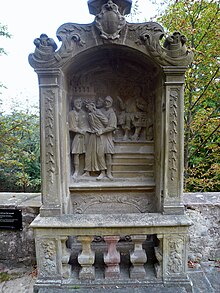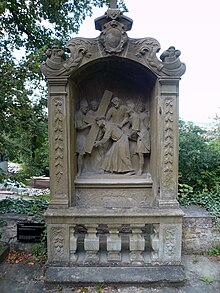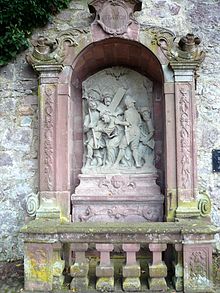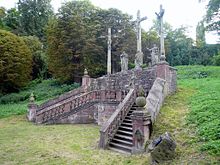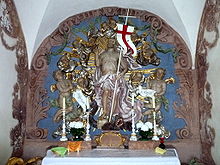Kapellenkreuzweg monastery old town
Coordinates: 50 ° 6 ′ 38 " N , 9 ° 52 ′ 23.6" E
The Kapellenkreuzweg Kloster Altstadt is west of Hammelburg in the Lower Franconian district of Bad Kissingen and was built in 1733. Designed as a circular route, it leads around one kilometer around the old town monastery , on the forecourt of which the starting and ending point is located. The Way of the Cross is the culmination of decades of construction work on the old town monastery. It gained national importance for the time and served as a model for other ways of the cross.
history
The Franciscans (OFM) received in 1686 by Pope Innocent XI. the right to the crossroads indulgences to grant. These were initially limited to the friars, then in 1726 under Pope Benedict XIII. extended to all believers. According to the Catholic view, the pilgrims were partially or completely exempted from the temporal penalties for sin through prayers . In the first half of the 18th century this led to a heyday of devotion to the Cross. Thereupon the brothers of the Franciscan monastery Altstadt, which was founded in 1649 by the Thuringian observant province of St. Elisabeth, had the Way of the Cross with 14 stations laid out in 1733. Thus, in this form, a unique specimen was created in the area of the Hochstift Fulda . The already popular place of pilgrimage to the 14 helpers in need experienced a renewed upswing.
Up until the 1980s, the Lombardy Chapel Crosses were cited as a model for the Way of the Cross in the Old Town monastery, for example in Orta San Giulio and Vares. This assessment can no longer be found in the current literature. In the meantime, the Chapel of the Cross at Kreuzberg Monastery in the Rhön region , which was first built in Germany in 1710, is a direct model. The reason for this assumption are the many conspicuous parallels: With the exception of station 12, both crossroads have stations designed as chapels and in both the twelfth station is at the highest point of the crossroads. Both crossroads have an elaborately designed 14th station in the form of a burial chapel. However, there is a difference: At Kreuzberg Abbey in the Rhön, this is near the summit and far away from the first station. At the old town monastery, the 14th station is directly in front of the church, a few meters away from the first station. Thus, the circular route is completed in that the pilgrim returns to the starting point with the last stop.
The establishment of the Old Town Crossing was recorded in the chronicle of the Old Town Monastery in 1886:
“In 1733 the stations of the cross in the old town were built with the permission of the clergy in Fulda. They are made of stone and painted, and a Franciscan has made a chronostitch for each station . "
Father Adrian Zeininger, who wrote this down in the chronicle in 1886, gave no information about the state of preservation of the Way of the Cross. After the turn of the century, in 1909, the Guardian Zeininger reported the alarming condition of the Way of the Cross to the monument protection authorities , which they then dealt with. Two representatives of the General Conservatory for the Preservation of Art Monuments in Bavaria examined the individual stations of the Way of the Cross and determined that they were in need of renovation. It turned out that the images were originally colored and only later painted over with white paint. Another report on the condition of the Way of the Cross was to be read in the Hammelburger Journal on July 13, 1909. The author of the article is of the opinion that the renovation of the Way of the Cross is urgently needed. The niches are partially dilapidated and the figures are often mutilated. At several stations, the locking grids would be loose and the inscriptions illegible.
First phase of renovation
In connection with the renovation - 176 years after the creation of the Stations of the Cross - the monastery for the first time asked itself who is the owner of the land of Stations 4 to 12. The other stations are on the monastery grounds. Then it was determined on the basis of the Hammelburg floor plan that stations 4 to 8 and 13 are on the ground of the city of Hammelburg. Stations 9 to 11 are on the property of the Pfaffenhausen Loan Association . Station 12 is on a plot of land for which the then owner of Saaleck was litigating the previous owner. On April 13, 1909, the Guardian finally reported to the Hammelburg District Court that all parties involved agreed to the registration of the rights.
After the ownership structure had been regulated, stations 1 to 8 were restored from September 1909 to October 1915 with public and private donations but also with the active help of the population. The renovation work began on September 10, 1909 at the eighth station , under the direction of the Würzburg sculptor Mathias Kemmer, as it was the most dilapidated. As with the other stations later, the relief was completely cleaned of the old painting and the natural stone was repaired. However, a new painting was no longer applied. Damaged parts of the figures were repaired, the inscription panels were partially renewed.
The second renovation with stations 9 to 14 took place around 20 years later. Station 12 was restored in 1933. After the completion of the renovation work at this station on July 23, 1933, the 200th anniversary of the Chapel Crossing was celebrated. At this festival, donations were collected in order to be able to continue the renovation work on the Way of the Cross. The renovation phase lasted until September 6, 1941, including adding missing parts of the inscription and removing the individual chapel grilles. The missing sections of the inscription could partly be added after studying the monastery chronicle ( Annales Conventus Palaeopolitani - volumes two and three). In addition, the grids of the individual stations were given a new coat of paint. After the Second World War, various individual stations were renovated.
Second phase of renovation
From 1993 to 1996 the entire Way of the Cross was completely restored . The obvious damage to the stations was repaired. Attempts were also made to counteract the further decline of the Way of the Cross. City architect Adolf Weibel and his colleague Reiner Baden from the city building department took over the supervision of the construction work carried out by the Muth company from Ebensfeld . Dr. Annette Faber from the Bavarian State Office for Monument Preservation was on hand to advise. During the renovation phase, the individual stations were provided with weather protection. At the request of the monastery, during this restoration an attempt was made to add legible inscriptions to the individual chapels, some of which had become illegible. The investigation found that the addition during the first renovation at the beginning of the 20th century was faulty in several cases. There were problems with stations one, two, ten and 13. The names of the donors could not be added everywhere.
The restoration costs amounted to around 370,000 euros and were raised by the city of Hammelburg with grants from the State Office for Monument Preservation , the State Foundation and the Diocese of Würzburg. In 1999, explanatory boards were installed next to the 14 stations, on which the description of the station motifs and Bible verses written by Pastor Treutlein can be read.
course

The Way of the Cross as a circular route is a rarity among the Way of the Cross devotions. This form only appeared occasionally in the Baroque era . The beginning and end of the path is the forecourt of the monastery church. The closed shape was planned from the start. On one side the avenue leads upwards and on the other side the stairway leads back to the monastery church. The 14 stations are roughly equidistant from each other. The crucifixion group stands on a plateau with a view of the city, the cellar castle and the Franconian Saale valley .
The Chapel Cross Trail starts on the church square on the north side of the church at a height of 203 meters above sea level and 30 meters above the Franconian Saale. The first and second chapels are right next to the monastery wall. The third station is on the west side. Stations four to six are partially embedded in the outside of the northern monastery wall. The path then climbs slowly, leads around the southeast corner of the monastery and becomes steeper. Stations seven and eight follow on the outside of the east wall. The path turns west at the end of the east wall and leads steadily uphill as an avenue with old chestnut trees and lime trees and stations nine to eleven within the forest. The twelfth station, the crucifixion, is at the highest point of the Way of the Cross, about 270 meters above sea level, less than 100 meters from Saaleck Castle and about 15 meters below the castle. This elevated place symbolizes the mountain Golgotha , also called the Calvary . Then follow the western wall down a stairway to the monastery. The 13th station is on the stairway. The end of the Way of the Cross is the burial chapel on the church square within the monastery and only a few meters from the first station.
description
The individual stations of the cross are designed as chapels with arched niches ; the frame is formed by pilasters with decorative ribbons made of acanthus leaf threads , flowers and blossoms. Above the pilasters extends a blasted gable decorated with scrollwork and acanthus , a gable shape in which the central part is cut out and not closed. The stations are numbered on cartridges on the gable, the gables are crowned with crosses. The chapel niches are preceded by balustrades . In the space created in this way, the figure relief is on a high base, underneath a base cartouche with an inscription. The stations were originally painted in color and closed with bars. Today there are only a few remains of color, and only grids are found at stations seven and eight, while at the others only the hinges can be seen. With the exception of stations 12 (crucifixion) and 14 (burial chapel), the chapels are around two meters wide and around 3.5 meters high. The figure relief itself is about 1.2 meters wide and about 1.5 meters high.
The inscriptions describe the events of the respective station in Latin and German. The name of the founder can be read underneath. The Latin inscriptions are mostly designed as a chronogram . The letters I , V , X , L , C , D , and M are highlighted as Roman numerals , the addition of which results in the year 1733, the year in which the Way of the Cross was built.
Seven chapels of the 14 stations - one, two and seven to eleven - are made of greenish-yellow, stations three to six and twelve to 14, including the crucifixion group and the burial chapel, are made of red sandstone , the latter being more ornate with crankings and volute scrolls on the sides . The reason for this is that the red sandstone chapels are in exposed places, for example on the pilgrimage route.
The figure reliefs and the figures of the crucifixion and the burial chapel are all made of greenish-yellow sandstone. Traces of the original painting are still present on some relief figures. In 1996, during the renovation, Christ's crown of thorns was given fresh gilding . Due to the renovation measures, the current appearance of the reliefs differs from the consistently colored design of that time, which was intended to appeal to popular piety.
The burial chapel, also made of red sandstone, protrudes as a risalit from the monastery wall. In the facade design with the blown gable and cross crowning, the side volutes and the balustrade, motifs of the stations were consciously adopted. The grave chapel has a gable field above the entrance with a richly decorated cartouche and the double coat of arms of the donor couple Hugo Phillipp Eckenbert von Dalberg and Anna Zobel von Giebelstadt .
At the individual stations, the scenes of the respective Passion event are depicted with many figures and numerous details. Christ's adversaries are depicted with grimaceous and exaggerated faces. The former colored painting of the reliefs should make it easy to distinguish good and bad and encourage the suffering figure of Christ to compassion.
Artist
The artists of the Hammelburg Way of the Cross also designed the Way of the Cross at the Volkersberg Monastery near Bad Brückenau and in Fulda on the Frauenberg and the Kalvarienberg. It was the Hammelburg sculptor Johann Jakob Faulstieg (1697–1768) and his assistant, the Franciscan brother Wenzeslaus Marx (1708–1773) from Leitmeritz . The concept of the Way of the Cross, the chapel design and the composition of the figure reliefs come from Faulstieg. The unity of the composition, the convincing depth of the space-creating figures refer to him. Faulstieg worked with overlapping figures and also designed back figures. The figures are usually of a compact build with rather rounded faces.
The work of Wenzeslaus Marx can be recognized by the excessively long figures, such as the reliefs of stations two and three. The surface design is less lively, the drapery more restrained. When dealing with overlapping figures, he is much more hesitant than Faulstieg. The reliefs executed by Wenzeslaus Marx appear somewhat stiffer. At some stations both artists worked together on the figure reliefs. For example, the group around Christ at the first station comes from Wenzeslaus Marx and the palace architecture with balustrade and arcade arches from Faulstieg. Both of them also worked on the free-standing crucifixion group.
However, a third artist must have been involved in the elaboration of the Way of the Cross. The figure reliefs of the seventh and eighth stations clearly indicate a workshop work in their execution, as the scenes depicted are lacking in conciseness. The expression of the figure faces remains unclear. The artist also showed weaknesses in the anatomically correct rendering of bodies. All of this speaks for a workshop journeyman from Faulstieg.
The elaborate design and the baroque layout of the Way of the Cross can be attributed to the influence of Andrea Gallasini . From 1725 to 1733, the master builder from Mantua undertook the redesign of the cellar castle on behalf of the prince abbot of Fulda, Adolf von Dalberg . He designed the garden side with an arbor . These arcade motifs and the balustrade design can be found on the chapels of the Way of the Cross. The conception of the Way of the Cross with a baroque line of sight to the cellar castle was probably also inspired by Gallasini.
Description of the chapels, inscriptions and reliefs
At the stations, the respective scene is briefly described in Latin elegiac distiches (translation below in round brackets) and in German (in lyrical form). Parts of the inscription that could no longer be deciphered after the long period of decay were left exposed on the inscription panels during the restoration work. Additional suggestions by the restorer are included in square brackets ([…]) below. Since 1999, a Bible verse has been quoted on an adjacent board at every station .
Station 1 - Jesus is sentenced to death
The chapel of the first station made of greenish-yellow sandstone is integrated at the back into a boundary wall of the church square. A restoration that began in spring 1910 was completed by July 24, 1910. The inscription was partially incorrectly added, as it turned out between 1993 and 1996 during the second restoration. In contrast to the other chapels, the stone with the relief sits directly on the stone with the inscription cartouche. Two hinges have been preserved from the former door grilles on the right side.
The pictorial program of the first station shows the condemnation of Christ by Pilate . On the left, Christ, surrounded by three henchmen , is tied up and wearing a crown of thorns. Seated on a throne to the right, Pilate raises both hands. In between, a boy appears, almost covered, with a water vessel. This and the raised hands of Pilate are an indication that he was washing his hands in innocence. The relief of the chapel shows a richly structured palace architecture with a balustrade and arcades in which the flagellation of Christ can be seen.
Station 2 - Jesus takes the cross on his shoulders
The chapel of the second station made of greenish-yellow sandstone is connected at the rear with a low wall surrounding the church square. Together with the first station, its first restoration was completed by July 24, 1910. Here, too, the inscription is partially incorrectly added. A second restoration took place between 1993 and 1996. As with the first chapel, the stone with the relief sits directly on the stone with the inscription cartouche and again only two hinges of the former door grille are preserved on the right side.
The pictorial program of the second station shows how Christ takes the cross on his shoulders. Of the six thugs, three mock him with their mouths open. The numerous lances of the soldiers appear in the background in front of city architecture. The excessively long figures appearing in this relief indicate the work of the Franciscan brother Wenzeslaus Marx (1708–1773) from Leitmeritz .
Station 3 - Jesus falls under the cross for the first time
The chapel of the third station made of red sandstone is only connected to the low boundary wall of the monastery behind it. It was completely restored for the first time by the restorer Kemmer between May 18 and July 23, 1911. A second restoration took place between 1993 and 1996. The stone with the relief stands on a convex profiled cornice stone, the front end of which is dominated by an open shell. There is no evidence of former door bars. The balustrade has four columns as a special feature.
The pictorial program of the third station shows the scene, which does not occur in the Bible, of Christ collapsing under the cross for the first time. Exhausted and sunk on his knees, the soldiers forced him to continue by pulling his hair and shackling ropes. In the background a rider rises in front of a palace architecture.
Station 4 - Jesus meets his mother
The chapel of the fourth station made of red sandstone stands at the back of a high natural stone wall and is connected to it. When it was restored from the end of July to the beginning of August 1912, it was almost half a meter in the ground and first had to be exposed. Many damaged details on the figures in the relief also had to be replaced. During the second restoration from 1993 to 1996, the Lömpel company from Arnstein installed vertical insulation between the natural stone wall and the chapel, which prevents further moisture penetration from behind. The convex cornice under the relief is dominated by a floral ornament. Evidence of former lattice doors can be found on both sides.
The picture program of the fourth station shows the meeting of Jesus with his mother Mary . Weeping, Mary turns to her son from the left. Jesus takes his mother's hand comfortingly. A second female figure looks over Maria's shoulder. The four henchmen, wearing different headgear, are already urging him to move on.
Station 5 - Simon of Cyrene helps Jesus carry the cross
The chapel of the fifth station, which is partially embedded in the monastery wall, is made of red sandstone. It was completely restored for the first time from May 21 to July 5, 1915. During the second restoration phase, it was completely expanded, the wall niche deepened and lined, and the plinth with writing tablet and relief rebuilt free-standing without contact with the rear wall. The relief stands on a convex profiled stone, the front end of which is dominated by an angel's head with two wings. Only a hinge on the right side is evidence of the former door grilles. The balustrade has four columns as a special feature.
The pictorial program of the fifth station shows how Simon of Cyrene helps to carry the cross. The tormentors of Christ, with four different headgear, crowd around him and drive him on. Simon of Cyrene, in the relief on the right, has grasped the lower end of the cross. He is shown with a turban and beard. Not enthusiastic about the burden, he reluctantly looks to the side.
Station 6 - Veronica gives Jesus the handkerchief
The chapel of the sixth station made of red sandstone is connected to the monastery wall behind it. The first restoration took place in September and October 1915. During the second restoration from 1993 to 1996, the chapel was completely expanded, the wall niches were deepened and bricked up accordingly, and the plinth with writing tablet and relief was rebuilt free-standing without contact with the rear wall. The relief stands on a convex profiled cornice stone with a strongly stylized shell-like ornament. Evidence of the hinges of the former lattice doors can be found on both sides. Like the third and fifth stations, the balustrade has four columns as a special feature.
The pictorial program of the sixth station shows how Christ is handed a handkerchief by Veronica on his further journey . This enters the scene from the right. She is also followed by a woman (as in the fourth station of Mary). Christ, his face turned conspicuously towards the viewer, is stabbed in the back by a henchman with a stick and thus driven to move on.
Station 7 - Jesus falls under the cross for the second time
The chapel of the seventh station, made of greenish-yellow sandstone, is integrated at the rear into the man-high east wall made of natural stone. During the first renovation in October 1910, the donor inscription was added. The second renovation took place from 1993 to 1996. The lower sixth of the relief forms a cornice with a straight profile, the front of which has a stylized butterfly-shaped ornament. The lattice doors are completely preserved. The discharge information is given on the upper cartridge.
The pictorial program of the seventh station shows the scene, likewise not handed down from the Bible, of Christ collapsing a second time under the cross. Although he is more bent than the first time (compare station three), the visual effect is further enhanced by a short figure on the left and a soldier sitting on the long cross beam. He is further mocked by the henchmen of Pilate by pulling his hair and trampling. Behind the scene, as in station three, a rider rises.
Station 8 - Jesus meets the weeping women
The chapel of the eighth station, made of greenish-yellow sandstone, is, like station seven, integrated at the rear into the head-high east wall made of natural stone. Most dilapidated at the beginning of the 20th century, this station was restored under the direction of the Würzburg sculptor Mathias Kemmer since September 10, 1909 and inspected by the royal conservator Angermaier on January 10, 1910. A second restoration took place from 1993 to 1996. The relief is placed on a semi-convex, semi-straight profiled cornice stone, the front of which has a stylized flower-shaped ornament. As with the seventh station, the lattice doors and the discharge information on the upper cartridge have been preserved.
The pictorial program by an unknown third artist shows in the eighth station how Christ comforts the weeping women along the way. He turns to a woman with a child coming from the right, who is drying her tears with a cloth. To do this, he turns almost completely while two soldiers pull him on the left.
Station 9 - Jesus falls under the cross for the third time
The chapel of the ninth station made of greenish-yellow sandstone is completely free-standing. During the restoration from August 21 to September 6, 1941, the missing parts of the relief and the inscription were added by the Würzburg sculptor Andreas Winzheimer. During the second restoration from 1993 to 1996, the underground station was exposed on three sides and isolated by installing a drainage system. As in station eight, the cornice under the relief is convex at the top and straight at the bottom. An outwardly curved shell is emblazoned on the front. Remnants of the hinges of the lattice doors are only preserved on the right side.
The pictorial program of the ninth station shows how Christ falls for the third time under the cross. This time he is turned to the right and is trampled on. One of the condemned thieves , recognizable by the missing robe, helps him to pick up the cross again. In the background, the rider appears again in front of the palace architecture and a church.
Station 10 - Jesus is stripped of his clothes
The chapel of the tenth station made of greenish-yellow sandstone is also free-standing. During the restoration phase from August 21 to September 6, 1941, missing parts were added to the relief and the inscription. During the second restoration from 1993 to 1996 it was found that the inscription cartouche had already been so badly damaged during the last restoration that only the Latin inscriptions could be replaced. This station was also exposed on three sides in the ground and isolated from the environment by a drainage system. The cornice stone, stepped on both sides towards the center, is dominated by an oval pattern. Remnants of the hinges of the lattice doors are only preserved on the right side.
The pictorial program of the tenth station shows how Christ is undressed by the soldiers. Of the five soldiers, three wear a similar helmet. The soldier in the front right carries a sword in a strikingly Arabic-oriental shape on his belt. In the heavily centered scene, they pull the robe off Jesus, whose crown of thorns is gold-plated. The mountain Golgotha can already be seen in the background.
Station 11 - Jesus is nailed to the cross
The chapel of the eleventh station, made of greenish-yellow sandstone, is the third in a row to be free-standing. It was restored from August 21 to September 6, 1941, missing parts of the inscription and the relief were added. During the second restoration from 1993 to 1996 it was exposed in the ground on three sides and isolated by installing a drainage system. The cornice between the relief and the inscription is profiled with double steps towards the middle and is dominated by a strongly stylized flower pattern. On the upper cartridge parts of the original discharge inscription and parts of a later inscription “STATIO” can be seen one above the other. As evidence of the lattice doors, hinge mountings are only preserved on the right side.
The pictorial program of the eleventh station shows how Jesus is nailed to the cross. While a soldier is driving a nail through his feet on the right, a soldier is holding the sign with the inscription " SPQR " in his hand on the left. Standing over the cross, three soldiers pull Jesus on ropes that are tied around his wrists. On the right side, two people with open mouths and partially raised hands mock or accuse the crucified one. In the background, the view goes from Mount Golgotha down to a settlement that is reminiscent of a Franconian city in terms of its architectural design .
Station 12 - Jesus dies on the cross
The central station of the Way of the Cross is the twelfth, shown is the crucifixion of Christ. Like the crucifixion of Christ on Golgotha, this station rises at the highest point of the Way of the Cross and is designed like a theater. It is laid out as a large, free-standing group of figures and is located directly at the foot of Saaleck Castle . The crosses stand on rocky ground, symbolizing Mount Golgotha, and can be reached via a two-armed staircase with a balustrade. The base zone bears the year 1733. Plants, animals and skeletons are depicted in the rocky ground as a sign that all creation is affected by Christ's work of redemption. Banners and cartouches with inscriptions indicate what happened out of faith . On both sides of the parapet there is a putti with inscriptions.
In the middle appears Christ with a crown of rays. Mary kneels praying on his cross. The apostle John is shown on the right. The wailing Maria Magdalena rises to the left. The action is framed on the right and left by the two crucified thieves. Christ, dying, leans toward the repentant thief. The other fellow crucified turns away from the Savior with his tongue out.
Station 13 - Jesus is taken from the cross
The red sandstone chapel of the 13th station is free-standing. Restored from August 21 to September 6, 1941, the sculptor Andreas Winzheimer added missing parts of the inscription and the relief. Although this station had already been restored in 1988 by the Westheim sculptor Siegfried Herterich for 30,000 German marks , which was covered by a donation from Sparkasse Bad Kissingen , it was renovated again from 1993 to 1996. Despite the triple restoration efforts in the 20th century, the relief shows the greatest signs of destruction on the entire Way of the Cross. The convexly profiled cornice stone below the relief is dominated by a large inwardly curved shell, in which a small, outwardly curved shell is placed. Evidence of the former lattice doors is completely missing.
The picture program of the 13th station shows the Descent from the Cross . The dead Christ has sunk into the womb of his crying mother. Next to her, his feet grasp the figure of Nicodemus on the back . Mary Magdalene and John appear on the right. The cross in the background, on which two ladders lean, is inscribed “ INRI ”.
Station 14 - The body of Jesus is placed in the grave
The 14th station is designed as a closed burial chapel, which is integrated into the monastery wall. It was restored for the first time from May to October 1934, and the destroyed facade and the almost unrecognizable coat of arms were restored. The interior and the windows of the burial chapel were also renovated, the work was completed by September 15, 1935. A second restoration was carried out in 1987, the third from 1993 to 1996. The color is the only one of the 14 reliefs that has been preserved or at least restored. The painting of the figures in the burial chapel comes from the renovation in 1935.
The relief shows the body of Jesus in a rocky grave in front of the altar, weeping by angels. Behind and above the altar he is shown as a risen one , framed by a ray manderola. Two whole angel figures and at least eleven angel heads frame the upward looking figure of the victor with the cross flag.
| Inscription of the upper cartridge: |

|
|
I n C r VC e s V ff IXVM proto VID ere parentes. Haere DI s L arga e X str VI t V r p I etate sep VLC hr VM |
|
| Translation of the upper cartridge: | |
| Inscription above the door: |
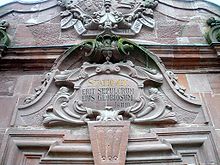
|
|
STATIO XIV. |
|
| Translation: | |
| His grave will be glorious. |
Model effect for later ways of the cross
Soon after the completion of the Old Town of the Cross, the artist Faulstieg was commissioned to build further prayer trails in the Fulda Monastery. The effect of the Chapel Way of the Cross reached as far as Würzburg. There, according to plans by Johann Balthasar Neumann, a station path on the Käppele with individual chapels as pavilions reminiscent of baroque palace architecture was laid out. There are life-size, free-standing figures in it. The Kapellenkreuzweg Kloster Altstadt formed a preliminary stage for the design there.
literature
- Tilmann Breuer et al. (Arr.): Dehio. Handbook of German Art Monuments, Bavaria I (Franconia) . Munich and Berlin 1999, p. 21.
- The Chapel Cross of the Franciscan Monastery Old Town near Hammelburg: an inventory of the work of art . Edited on behalf of the Franciscan monastery Altstadt. Reiner Baden (photo); Hartwig Gerhard (inscription). With an introductory contribution by Astrid Hedrich-Scherpf. Hammelburg 2002.
- Karen Schaelow-Weber, Benno Fischer (ed.): Hammelburg - Franciscan monastery old town. Illustrations by Gregor Peda. Passau 1998 (= Peda art guide number 412). ISBN 3-89643-068-8 .
- Old town monastery (ed.): Annales Conventus Palaeopolitani. Volumes two and three, ([unprinted] manuscript, here quoted from: The Chapel Cross of the Franciscan Monastery Old Town near Hammelburg ).
Web links
Individual evidence
- ↑ Church guide of the old town monastery. Page 19.
- ↑ a b c d e The Chapel Cross of the Franciscan Monastery Old Town. Page 10.
- ^ Annales Conventus Palaeopolitani. Volume two, page 128 f.
- ^ Hammelburger Journal. Issued July 13, 1909.
- ↑ The Chapel Cross of the Franciscan Monastery Old Town. Page 42.
- ^ Annales Conventus Palaeopolitani. Volume two, page 145.
- ^ Annales Conventus Palaeopolitani. Volume three, page 41.
- ↑ The Chapel Cross of the Franciscan Monastery Old Town. Page 43.
- ↑ a b The Chapel Cross of the Franciscan Monastery Old Town. Page 9.
- ↑ a b The Chapel Cross of the Franciscan Monastery Old Town. Page 11.
- ↑ The supplementary suggestions given come from The Chapel Cross of the Franciscan Monastery Old Town.
- ^ Partly reconstructed inscription in The Chapel Cross of the Franciscan Monastery Old Town , 1st station.
- ↑ Partly reconstructed inscription in The Chapel Cross of the Franciscan Monastery Old Town , 2nd station.
- ^ Annales Conventus Palaeopolitani. Volume 2, pp. 165f.
- ↑ Partly reconstructed inscription in The Chapel Cross of the Franciscan Monastery Old Town , Station 10te.
- ↑ The inscription was accidentally incorrectly restored in 1941. You can read POLITRISTES , which has to be called POLITRISTRES .
- ↑ Partly reconstructed inscription in The Chapel Cross of the Franciscan Monastery Old Town , XIII. Station.













